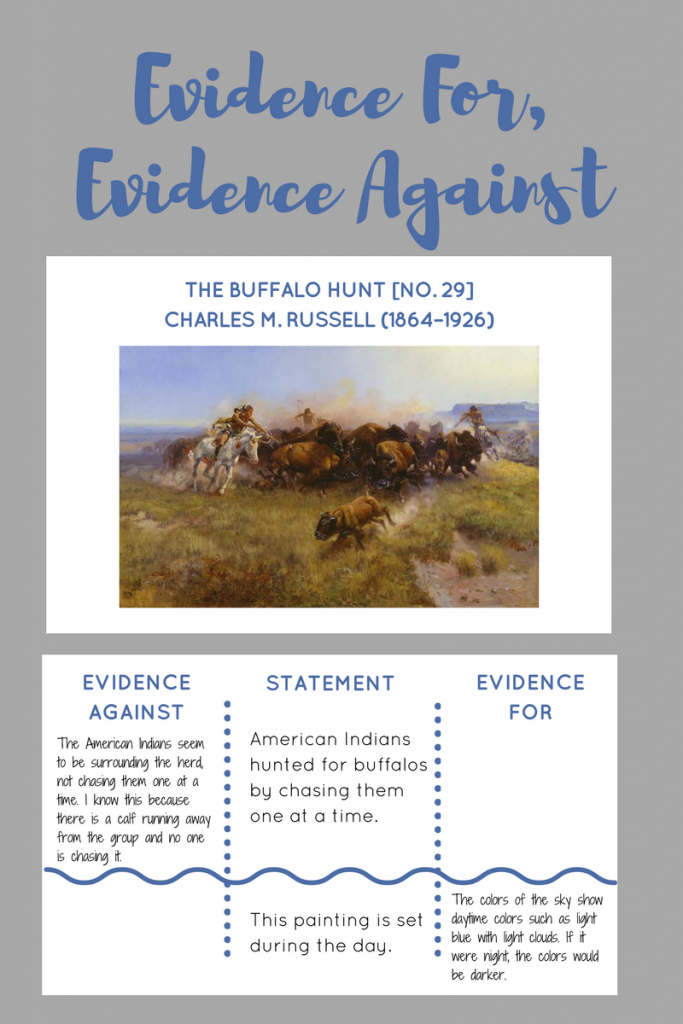“Evidence For, Evidence Against” is a teaching strategy that helps students “close read” a piece of text. Under the Common Core Standards’ definition for text, literature, music, visual art, dance, and drama apply. This allows us to successfully apply the teaching strategy across our Arts subjects. “Evidence For, Evidence Against” compares to a rigorous true and false activity, requiring students to share evidence to support or argue a statement. This forces students to go back to the text and examine it closely to respond. There is no way to do this without thinking deeply about the text itself, allowing students to make discoveries they may have otherwise overlooked.
How to Implement “Evidence For, Evidence Against”
To use this teaching strategy, students are presented with a three-column chart that includes statements in the middle column. This can be used after reading or during the reading experience. The statements are pulled from the text, however, some are true statements, and some are not. Students determine if it is true or false, and then provide the text evidence to prove it correct or incorrect. For example, take a look at an excerpt from the text Lon Po Po: A Little Red Riding Story by Ed Young. Then, take a look at a simple example on the Evidence Chart excerpt with the student answer.

This example is directly related to the words the author uses, but the same concept applies when using the strategy to prove the theme, pointing out the author’s craft, or with nonfiction guide students to analyze text structure. It also requires them to know and use tier 2 vocabulary.
Using “Evidence For, Evidence Against” with the Arts
When using this teaching strategy with the Arts, the same guidelines apply. To follow the way we used it with literature, students can find Evidence For or Evidence Against visual art by analyzing the content of the art. Create a true or false statement for the chart. Statements, of course, will be different depending on your grade level and how much background your students have on the topic and the art form. This can apply to music, dance, and theater as well.
Take a look at the example for the piece The Buffalo Hunt [No. 29] by Charles M. Russell. Students can explore this artwork (as well as many others) virtually through Google’s Arts and Culture “Zoom In” section, found here.

Introducing the Teaching Strategy to Students
When I use this teaching strategy with students, we first complete it as a whole group so that I can demonstrate the amount and type of evidence we need. Students sometimes get confused on their own, thinking that they need to fill in all of the boxes on the chart. After the initial instruction, I almost always have them use this strategy with the text and a partner. If they are without the text, as some students think they can rely on their memory, it is impossible to cite the evidence at a specific level. Allowing students to work with a partner can help students bounce ideas off one another and they are able to work together as a team to find the evidence they need.
After The Strategy
We follow up by discussing answers as a class. This tends to get heated, but in a good way. Students share their evidence, and if the statement is challenging enough, other students tend to disagree, basing their argument on different evidence in the text. This type of disagreement is a great way for the group to grapple with the text itself to determine what the author or artist means. It takes a bit of training to help students “argue” in a beneficial way, but they have a lot of fun when the discussions become passionate.
I love hearing a student explode with a statement like, “No, no- I disagree! On page 16, the author says …., so that CAN’T be true.” I’ve worked to create a culture where students can disagree with each other (and with me!) provided they have the evidence to support it. Not only does it allow for great higher-level discussions, but it gives students purpose for their learning while getting them back into the text. It also helps them develop the necessary social skills for disagreements.
“Evidence For, Evidence Against” Extensions
After students master the strategy, I have them create the statements. I typically do this by drawing the three-column chart on a piece of chart paper. As they think of a tricky true or false statement, they add it to the middle column. Other student groups can write on the chart to prove or disprove the statement with evidence.
Are you interested in trying this strategy with your students? Check out the resources below. You’ll find a full example for the story Lon Po Po, created by a colleague of mine, without student answers. In addition, you can download an editable blank version for you to try with any piece of text or art.



